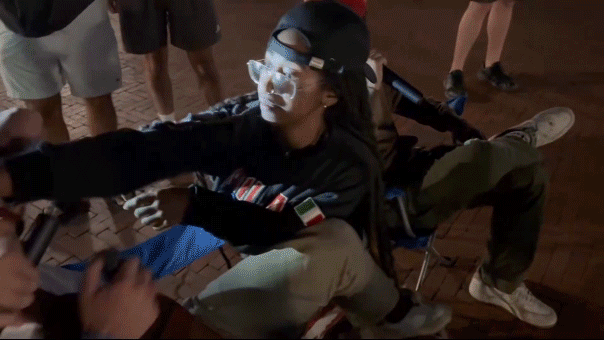Conservative Activist’s Viral Confrontation Highlights Political Tensions in America
In a tense encounter that quickly went viral, conservative activist Cam Higby found himself at the center of controversy after pepper-spraying a woman who allegedly attacked him at Washington D.C.’s Union Station. The incident, captured on video, shows a confrontation escalating when the woman reportedly lunged at Higby and struck him with his own MAGA hat. For Higby, this altercation represents more than just a personal attack—it exemplifies the mission behind his “Fearless Tour,” inspired by the late Turning Point USA founder Charlie Kirk, which aims to confront political hostility while encouraging open dialogue across ideological divides. As polarization in America continues to intensify, Higby’s experience raises questions about the boundaries between provocative political engagement and personal safety in public spaces.
The confrontation occurred after Higby hosted a debate event at the University of Maryland on Wednesday. According to his account, shared in a phone interview with Fox News Digital, he and his group were sitting at Union Station having conversations with nearby protesters when a woman approached and began acting confrontationally. “At some point, she dropped to her knees, intentionally… and she started yelling at us and started touching us,” Higby explained. Despite his warnings to stop touching him, the situation escalated when the woman allegedly pushed him back in his chair, took his MAGA hat, and hit him with it before falling into a bush—at which point Higby deployed pepper spray. The uncertainty of the moment was heightened by the woman keeping her hands in her pockets during most of the encounter, creating ambiguity about whether she might have been armed, according to Higby’s account of the situation.
What began as a heated political encounter soon involved law enforcement. After being pepper-sprayed, the woman reportedly received assistance from other protesters who helped wash her eyes and called police. While initially it appeared no arrests would be made, the arrival of U.S. Park Police changed the dynamic dramatically. Higby claims the woman became combative with federal officers, allegedly resisting arrest and assaulting them in the process. “It took four federal police officers to hold her down, and finally they loaded her into the back of the police car,” Higby recounted. Throughout this escalation, he described the woman’s father confronting him about pepper-spraying his daughter even as she struggled with law enforcement. Police reports subsequently listed Higby and his colleague as victims, with the woman reportedly facing federal charges, though U.S. Park Police did not immediately confirm her identity or the specific charges to Fox News Digital.
This wasn’t Higby’s first encounter with politically-motivated hostility. In June, he was allegedly attacked by three men at an anti-ICE rally in downtown Seattle—an incident that was also captured on video. During that confrontation, the men reportedly attempted to remove his equipment and physically assaulted him before he used pepper spray in self-defense. The attack left him with a concussion and other symptoms requiring emergency medical treatment. These experiences have led Higby to take precautionary measures: “I’ve come to the point where I carry Mace on me at all times,” he explained. He defends his use of pepper spray as showing “incredible restraint,” noting that he gave multiple verbal warnings before deploying it in the Union Station incident. Higby also points to a double standard in how his actions are perceived: “The roles are reversed, and I’m overly criticized because it’s a woman, but I don’t know what she has on her, and I’m not going to throw a punch at her. I think that using Mace is way better [alternative].”
On college campuses across America, Higby and his associates have become recognizable for their provocative debate tables inspired by Charlie Kirk’s approach, featuring signs declaring “The left is violent! Let’s Debate!” Critics argue such messaging deliberately provokes heated reactions rather than fostering genuine dialogue. However, Higby points out that the Union Station incident occurred without any such signage present—the only identifiable feature of his group being their MAGA hats. This raises questions about whether the mere symbols of political affiliation have become so charged in today’s political climate that they alone can trigger confrontations. Higby maintains that while he welcomes passionate political discussion, physical boundaries must be respected: “We want people fired up. We want people to be excited to talk about political issues, but what we don’t invite people to do is touch us, and that’s the problem.”
The incident at Union Station serves as a microcosm of America’s increasingly fractured political landscape, where disagreements frequently escalate beyond verbal exchanges to physical confrontations. For activists like Higby, these experiences reinforce their belief that political violence is predominantly coming from one side of the spectrum, while critics might view their approach as deliberately provocative. What remains clear is that as political tensions continue to simmer across the country, the line between vigorous debate and dangerous confrontation seems increasingly blurred. Higby’s defense of his actions reflects a broader concern among politically active Americans about personal safety in an era of heightened division: “I think most of my takes are pretty reasonable. That’s your problem, not my problem—if you have such low impulse control that you can’t stop yourself from using physical violence.” As Americans navigate an increasingly contentious political environment, incidents like these force a national reckoning with how we engage across ideological differences while maintaining civility and safety in public spaces.










